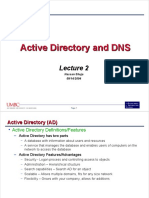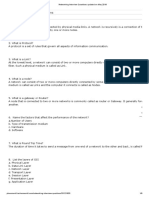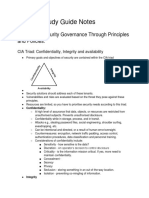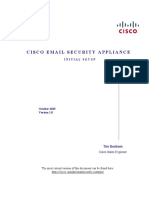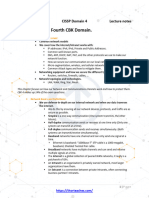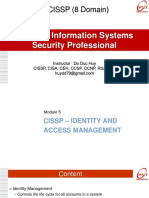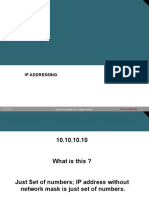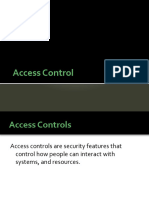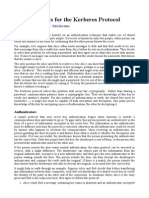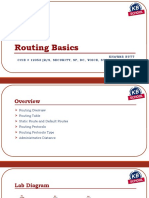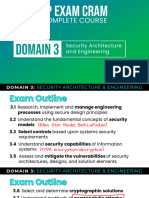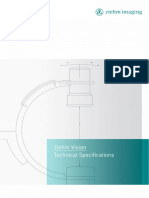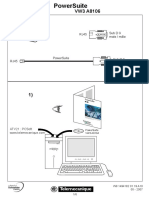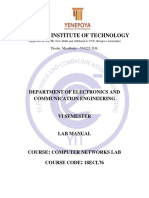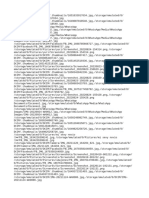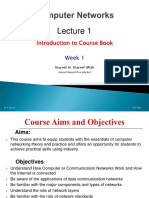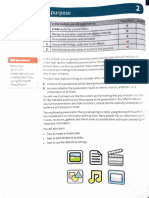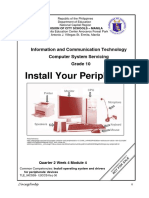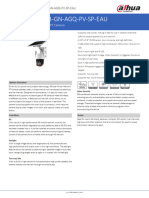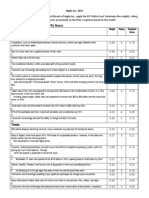CISSP (8 Domain)
Certified Information Systems
Security Professional
Instructor : Do Duc Huy
CISSP, CISA, CEH, CCSP, CCNP, RSA CSP
huydd79@gmail.com
Module 4
CISSP – COMMUNICATIONS
AND NETWORK SECURITY
Content
OSI Reference Model
Network Protocols
Network Connectivity Devices
Threats to Network Security
Firewalls
Wireless Communications
3
OSI REFERENCE MODEL
4
OSI MODEL
7 layers A P S T N D P… “All People Seem to Need Data
Processing”
Application
Presentation
Session
Transport
Network
Data link
LLC
MAC
Physical
5
OSI
6
ENCAPSULATION
7
OSI MODEL - LAYER 1 PHYSICAL
Layer 1 Physical – simply put is concerned with physically sending
electric signals over a medium.
Is concerned with
specific cabling,
voltages and
Timings
This level actually sends data as electrical signals that other
equipment using the same “physical” medium
8
OSI REFERENCE MODEL: LAYER 1
(PHYSICAL) TRANSMISSION
MEDIA/CABLING
9
OSI REFERENCE MODEL: LAYER 1
(PHYSICAL) TOPOLOGY
10
OSI REFERENCE MODEL: LAYER 1
(PHYSICAL) CONNECTIVITY DEVICES
11
OSI REFERENCE MODEL: LAYER 1
(PHYSICAL)
Threats:
Theft
Unauthorized Access
Vandalism
Sniffing
Interference
Data Emanation
12
OSI MODEL – LAYER 2 DATA LINK
LLC Logical Link Control - Error detection
Manages connections between two peers.
It provides error and flow control and control bit sequencing.
MAC Media Access Control - Physical
Addressing/Resolution and media access determination
ARP (Address Resolution Protocol
RARP (Reverse Address Resolution Protocol)
Media Access Control
CSMA/CD Carrier Sense Multiple Access with Collision Detection (IEEE standard)
802.3 Ethernet
CSMA/CA Carrier Sense Multiple Access with Collision Avoidance(IEEE standard)
802.11 Wireless
Token Passing
13
MEDIA ACCESS TECHNOLOGIES
CSMA/CD
Waits for clear, then starts
talking, detect collisions
14
MEDIA ACCESS TECHNOLOGIES
CSMA/CA
Signals intent to talk
For wireless
communication
15
MEDIA ACCESS TECHNOLOGIES
Token Passing
24 bit control frame passed around the network environment with the purpose
of determining which system can transmit data.
There is only one token and since a system can’t communicate without the
token, there are no collisions.
16
MEDIA ACCESS TECHNOLOGIES
Collision Domain – where collisions can occur.
17
ETHERNET
Most common form of LAN networking, has the following
characteristics
Shares media
Broadcast and collision domains
CSMA/CD
Supports full duplex with a switch
Defined by IEEE 802.3
18
ARP
IP to MAC
Arp table
arp -a
19
RARP
MAC to IP
20
SWITCH
Layer 2
Uses MAC addresses to direct traffic
Isolates traffic into collision domains
Does NOT isolate broadcasts natively
21
OSI MODEL LAYER 3 NETWORK
Broadcast domain is group of networked systems in which all other members
receive a broadcast signal when one of the members of the group transmits it.
Routers Isolate traffic into broadcast domains and use IP addressing to direct
traffic
22
VLANS
Routers are expensive
To get broadcast isolation
on a switch, a VLAN is
necessary
Not all switches support
VLANs
A Layer 2 switch (even with
a VLAN) doesn’t truly
understand Layer 3 IP
Addressing
A Layer 3 switch is
necessary for inter-Vlan
Communication
23
LAYER 3 PROTOCOLS
IP
ICMP – IP “helpers” (like ping)
IGMP – Internet Group Message Protocol
Routing (RIP, IGRP, OSPF)
IPSEC
IKE
ISAKMP
All Protocols that start with the letter “I” except IMAP (which is a layer 7
mail protocol)
24
IPv4
Internet Protocol version 4, commonly called “IP”
Fundamental protocol of the Internet
Designed in the 1970s to support packet-switched networking
Used for the ARPAnet, which later became the Internet
IP is a simple protocol, designed to carry data across networks
25
IPv4 Address
The address is expressed as four octets separated by a dot (.)
Eg: 216.182.132.237
Subnet mask using /
Class full address: A, B, C, D, E
A: /8
B: /16
C: /24
Classless Inter-Domain Routing (CIDR)
26
RFC 1918
10.x.x.x
172.16.x.x-172.31.x.x
192.168.x.x
27
ICMP
ICMP – “IP helper”
Protocol behind echoing utilities like PING and Traceroute
Frequently exploited
LOKI: sending data in ICMP headers — covert Channel
Ping of Death: violates the MTU (maximum transmission unit) size
Ping Floods: Lots of ping traffic
SMURF: Uses spoofed source address (Target) and directed broadcasts
to launch a DDos
28
ROUTING PROTOCOL
Specifies how routers communicate with each other
Distributing information that enables them to select routes between any two
nodes on a computer network
Two broad categories
Distance vector: RIP, IGRP, BGP
Link state: OSPF
Gateway Types
Interior gateway protocols: OSPF, RIP
Exterior gateway protocols: BGP
Routing table
29
RIP
RFC 1058 (RIPv1), RFC 1723 (RIPv2)
Distance vector algorithms
Selects the path with the least number of hops
30
OSPF
RFC 1131 (OSPFv1), RFC 1583 (OSPFv2)
Link-state routing algorithms
Calculating the shortest path based on a topography of the Internet constructed by each
node.
Router sends that portion of the routing table that describes the state of its own links
31
IGMP
Used to manage multicasting groups, which are a set of hosts anywhere on a
network that are interested in a particular multicast.
Multicast agents administer multicast groups, and hosts send IGMP messages
to local agents to join and leave groups
Uses for multicast services such as video on demand
32
IPv6
Successor to IPv4
A much larger address field:
IPv6 addresses are 128 bits, (IPv4?)
Improved security
A more concise IP packet header (less time to process)
Improved quality of service
33
OSI MODEL LAYER 4 TRANSPORT
OSI Layer 4 Transport –Provides end-to-end data transport services and
establishes a logical connection between 2 computers systems”
The “pony express”
Protocols used at layer 4
ATP – AppleTalk Transaction Protocol
DCCP – Datagram Congestion Control Protocol
FCP – Fiber Channel Protocol
RDP – Reliable Datagram Protocol
SCTP – Stream Control Transmission Protocol
SPX – Sequenced Packet Exchange
SST – Structured Stream Transport
TCP – Transmission Control Protocol
UDP – User Datagram Protocol
UDP Lite – User Datagram Protocol Lite
μTP – Micro Transport Protocol
34
TCP (TRANSMISSION CONTROL
PROTOCOL)
Connection oriented “guaranteed” delivery: Has a guaranteed delivery based on the
handshake process
Advantages
Easier to program with
Truly implements a session
Adds security
Disadvantages
More overhead / slower
SYN Floods
35
TCP SYNC FLOODS
36
UDP (USER DATAGRAM PROTOCOL)
Connectionless
Unreliable
No handshaking
Desirable when “real time” transfer
is essential
Media Streaming, Gaming, live time
chat, etc..
FTP uses TCP
TFTP uses UDP
37
TCP/UDP PORTS AND SOCKET
38
TCP vs UDP
39
OSI MODEL LAYER 5 SESSION
OSI Layer 5 (Session) – responsible for establishing a connection between two
APPLICATIONS! (either on the same computer or two different computers)
Create connection
Transfer data
Release connection
Three modes:
Full Duplex – Both hosts can exchange information simultaneously,
independent of each other.
Half Duplex – Hosts can exchange information but only one host at a time.
Simplex – Only one host can send information to its peer. Information
travels in one direction only.
40
LAYER 5 PROTOCOLS
ADSP – AppleTalk Data Stream Protocol
ASP – AppleTalk Session Protocol
H.245 – Call Control Protocol for Multimedia Communication
iSNS – Internet Storage Name Service
PAP – Password Authentication Protocol
PPTP – Point-to-Point Tunneling Protocol
RPC – Remote Procedure Call Protocol
RTCP – Real-time Transport Control Protocol
SMPP – Short Message Peer-to-Peer
SCP – Session Control Protocol
SOCKS – the SOCKS Internet protocol, see Internet socket
ZIP – Zone Information Protocol
41
OSI MODEL LAYER 6 PRESENTATION
OSI Layer 6 –present the data in a format that all computers can
understand
This is the only layer of OSI that does NOT have any protocol.
Concerned with encryption, compression and formatting
Making sure data is presented in a universal format
File level encryption
Removing redundancy from files (compression)
42
OSI MODEL LAYER 7 –APPLICATION
This defines a protocol (way of sending data) that two different
programs or applications understand.
HTTP, HTTPS, FTP, TFTP, SMTP, SNMP, etc...
Application Proxies
Non-Repudiation
Certificates
Integration with Directory Services
Time awareness.
43
TCP/IP MODEL
44
OSI VS. TCP/IP MODEL
45
TCP/IP PROTOCOL SUITE OVERVIEW
46
OSI/TCP…WHAT YOU NEED TO KNOW
47
THREATS TO NETWORK SECURITY
48
COMMON ATTACKS
Virus: Virus A piece of malicious code that can take many forms and serve
many purposes. Needs a host in which to live, and an action by the user to
spread.
Worm: Similar to a virus, but does not need a host and is self replicating
Logic Bomb: A type of malicious code that lays dormant until a logical
event occurs
Trojan Horse: One program (usually some type of malicious code)
masquerades as another. Common means of distributing Back Door
Programs
Back Door Programs: A Program that allows access (often administrative
access) to a system that bypasses normal security controls. Examples are
NetBus, Back Orifice, SubSeven
49
COMMON ATTACKS (CONT)
Salami: Many small attacks add up to equal a large attack
Data Diddling: Altering/Manipulating data, usually before entry
Sniffing: Capturing and Viewing packets through the use of a protocol
analyzer. Best defense: Encryption
Session Hijacking: Where an attacker steps in between two hosts and
either monitors the exchange, or often disconnects one. Session hijacks
are types of Man in the Middle attacks. Encryption prevents sniffing and
mutual authentication would prevent a session hijack
War dialing: An attack on a RAS (Remote Access Server) where the
attacker tries to find the phone number that accepts incoming calls. RAS
should be set to use caller ID (can be spoofed), callback (best), and
configured so that modem does not answer until after 4 calls.
50
COMMON ATTACKS (CONT)
Dos Denial of Service: The purpose of these attacks is to overwhelm
a system and disrupt its availability
DDoS Distributed Denial of Service: Characterized by the use of
Control Machines (Handlers) and Zombies (Bots) An attacker uploads
software to the control machines, which in turn commandeer
unsuspecting machines to perform an attack on the victim. The idea is
that if one machine initiating a denial of service attack, then having
many machines perform the attack is better.
Ping of Death: Sending a Ping Packet that violates the Maximum
Transmission Unit (MTU) size—a very large ping packet.
Ping Flooding: Overwhelming a system with a multitude of pings.
51
COMMON ATTACKS (CONT)
Tear Drop: Sending Malformed packets which the Operating System does not know how
to reassemble. Layer 3 attack
Buffer Overflow: Attacks that overwhelm a specific type of memory on a system—the
buffers. Is best avoided with input validation
Bonk : Similar to the Teardrop attack. Manipulates how a PC reassembles a packet and
allows it to accept a packet much too large.
Land Attack: Creates a “circular reference” on a machine. Sends a packet where source
and destination are the same.
Syn Flood: Type of attack that exploits the three way handshake of TCP. Layer 4 attack.
Stateful firewall is needed to prevent
Smurf: Uses an ICMP directed broadcast. Layer 3 attack. Block distributed broadcasts
on routers
Fraggle: Similar to Smurf, but uses UDP instead of ICMP. Layer 4 attack. Block
distributed broadcasts on routers
52
FIREWALLS, PROXIES, AND NAT
53
FIREWALLS AND THE OSI
Firewalls: Allow/Block traffic
Rules to Allow or Deny Traffic. Can be HW or SW
Layer 3: Static Packet Filters: Base decisions on Source/Destination
IP Address and Port
Layer 5 Stateful inspection. Knowledge of who initiated the session.
Can block unsolicited replies. Protocol Anomaly firewalls—can block
traffic based on syntax being different than the RFC would specify
Layer 7: Application Proxies/Kernel Proxies: Make decisions on
Content, Active Directory Integration, Certificates, Time
54
FIREWALLS
55
FIREWALLS
Enforce network policy.
Usually firewalls are put on the perimeter of a network and allow or
deny traffic based on company or network policy.
MUST have IP forwarding turned off
Firewalls are often used to create a DMZ.
Generally are dual/multi homed
Types of firewalls
Packet filtering
State full
Proxy
Dynamic packet filtering
56
PACKET FILTER
Uses Access control lists (ACLs), which are rules that a firewall
applies to each packet it receives.
Not state full, just looks at the network and transport layer packets
(IP addresses, ports, and “flags”)
Do not look into the application, cannot block viruses etc...
Generally do not support anything advanced or custom
57
PACKET FILTER
Packet filters keep no state
Each packet is evaluated own it’s own without regard to previous traffic
Advantages
Simple
Transparent to users
High speed
Disadvantages
Fragments: may got problem on filtering fragment traffic
Lack of authentication
Rule based access control
Packet filters are still used on the edge of the network before a
statefull firewall for performance reasons.
58
STATEFULL FIREWALL
Router keeps track of a connections in a table.
It knows which conversations are active, who is involved etc...
It allows return traffic to come back where a packet filter would have to
have a specific rule to define returned traffic
Disadvantage:
More complex
Can be a victim of DoS attack by trying to fill up all the entries in the
state tables/use up memory.
If rebooted can disrupt conversation that had been occurring.
Context dependent access control
59
DYNAMIC PACKET FILTERING
Like a state full firewall but more advanced.
Can actually rewrite rules dynamically.
Some protocols such as FTP have complex communications that
require multiple ports and protocols for a specific application, packet
and statefull filter cannot handle these easily, however dynamic
packet filter can as they can create rules on the fly as needed.
60
PROXY FIREWALLS
Two types of proxies
Circuit level
Application
Both types of Proxies hide the internal hosts/addressing from the
outside world
61
CIRCUIT LEVEL PROXIES
62
APPLICATION PROXIES
Like circuit layer proxies, but actually understand the
application/protocol they are proxying.
This allows for additional security as they can inspect the data
for protocol violations or content.
63
APPLICATION PROXIES
Advantages
Application proxies understand the protocol, so they can add
extra security
Can have advanced logging/auditing and access control features
Ex. Restrict users to only allowed websites
Ex. Inspect data for protocol violations
Ex. Inspect data for malware (viri etc..)
Disadvantages
Extra processing requires extra CPU (slower)
Proxies ONLY understand the protocols they were written to
understand. So you generally have a separate application proxy
for EACH protocol you want to proxy
64
APPLICATION PROXIES
Examples:
Internet Security and Acceleration Server (MS web proxy)
SMTP proxies
FTP proxies
65
SECURITY ZONES
It is common practice in network and physical security to group
different security levels into different areas or zones. Each zone is
either more or less trusted then the other zones. Interfaces between
zones have some type of access control to restrict movement between
zones (like biometric and guard stations) or firewalls.)
In Network security there is often a median zone between the Internet
and internal network called a DMZ.
66
DMZ
A buffer zone between an unprotected network and a protected
network that allows for the monitoring and regulation of traffic
between the two.
Internet accessible servers (bastion hosts) are placed in a DMZ
between the Internet and Internal network
67
DMZ
68
DMZ ARCHITECTURES
Multi-homed Firewall
Screened Subnet
69
MULTI HOMED FIREWALL
Multi-homed firewalls may be used to setup a DMZ with a single
firewall. (see next slide)
On any multi-homed machine, Ip forwarding (routing) should be
disabled.
70
MULTI HOMED FIREWALL
71
SCREENED SUBNET
In a screen subnet, there is a separate firewall on both sides of the
DMZ.
When using this model it is recommended that each firewall be a
different vendor/product.
Diversity of defense
72
SCREENED SUBNET
73
NAT/PAT
A proxy that works without special software and is transparent to the
end users.
Remaps IP addresses, allowing you to use private addresses internally
and map them to public IP addresses
NAT allows a one-to-one mapping of IP addresses
PAT allows multiple private address to share one public address
74
NAT
Computer 10.0.0.1 sends a packet to 175.56.28.3
Router grabs packet, notices it is NOT addressed to it. Modifies the src address to one
from it’s pool (215.37.32.202), then sends the packet on it’s way to the destination*
The end machine accepts the packet as it’s addressed to him.
End machine creates response, src = itself (172.56.28.3) dest = 215.37.32.202
Router grabs packet, notices the dest address, and looks up in it’s NAT table, rewrites
the dest to 10.0.0.1 and sends it on its way*
Originating machine grabs response since it’s addressed to him, he processes it.
75
NAT / PAT
Advantages
Allows you to use private addresses Internally, you don’t need to get real
public IP addresses for each computer
Protects the network by stopping external entities from starting
conversations to internal machines
Hides internal network structure
Transparent, doesn’t require special software
Disadvantages
Single Point of Failure / Performance Bottleneck
Doesn’t protect from bad content
76
OVERALL FIREWALL ISSUES
Potential bottleneck
Can restrict valid access
Often mis-configured
Except for application proxies firewalls generally do not filter out
malware or improper content.
Don’t protect against internal attacks!
77
OVERALL FIREWALL BEST
PRACTICES
Block un-necessary ICMP packets types.
(Be careful though, know your environment)
Keep ACLS simple
Use Implicit deny*
Disallow source routed packets*
Use least privilege*
Block directed IP broadcasts
Perform ingress and egress filtering*
Block traffic leaving the network from a non-internal address (indicates the network is
possibly being used as zombie systems in a possible DDoS attack.
Block all traffic entering the network from an internal address (indicates a potential
spoofing attack)
Enable logging
Drop fragments or re-assemble fragments
78
LAN/WAN TECHNOLOGY
79
LAN, WAN, MAN
LAN –local area network
High speed
Small physical area
WAN –wide area network
Used to connect LANS
Generally slow, using serial links
MAN –metropolitan area network
Connect sites together within a medium range area (like a city)
PAN
Personal (Bluetooth, Infrared, ad-hoc wifi)
80
CIRCUIT SWITCHING
81
CIRCUIT SWITCHING TECHNOLOGIES
PSTN
ISDN
DSL
T-carriers
82
DIAL UP (REMOTE ACCESS)
Disadvantages
Back door into networks (bypass firewall)
Often forgotten about
Slow
Attacks*
War dialing
Defenses*
Dial Back /
Caller ID restrictions
Use authentication
Answer after 4 or more rings (why/war dialing)
Use a different numbering convention for RAS
83
ISDN
Uses same lines as phone lines, directly dial into company or ISP
BRI
2 B Channels (64Kbits x 2)
1 D Channel (control channel) Out of Band
PRI
23 B Channels
1 D Channel
Not for personal use
84
ADSL
MUCH faster than IDSN (6-30 times faster)
Must live very close to the DSL equipment
Symmetric and Asymmetric
Always on (security concerns)
85
PACKET SWITCHING
86
PACKET SWITCHING TECHNOLOGIES
X.25
Frame Relay
ATM
VOIP
MPLS
Cable Modems
87
CABLE MODEM
High speed access up to 50Mbps via cable TV lines.
Shared bandwidth
Always on (security concerns)
88
MPLS (MULTI PROTOCOL LABELED SWITCHING)
MPLS is used to create cost effective, private Wide Area Networks
(WANs) faster and more secure than regular routed “public” IP networks
like the internet.
More secure than the public internet, because a “virtual” private network
(end-to-end circuit)can be built just for your organization
Since it’s a private network, we don’t have to configure and maintain
traditional encryption based Virtual Private Networking (VPN) equipment
anymore, and can also avoid the latency and delay inherent in this
technology.
Provides QoS for VOIP and other high priority traffic
Purely Layer 3 technology
89
MPLS
90
VOIP VOICE OVER IP
Converts analog to digital through use of
Telephony adapter or smartphone
Data is channeled though gateways
(often lacking in authentication
mechanisms leading to TOLL FRAUD)
At the end of a VOIP connection the
smartphone or TA converts the signal
back to analog
91
VOIP SECURITY ISSUES
Security
Eavesdropping (greatest threat)—Enable S/RTP
Toll Fraud
Vishing
SPIT (SPam over Internet Telephony)
Performance Issues
Latency
Jittering
92
REMOTE ACCESS PROTOCOLS
93
DIAL-UP
PPP Point to Point Protocol: Provides Layer 2 framing for dial-up.
Needs other protocols for security
Encryption: MPPE (Microsoft Point-to-Point Encryption)
Authentication:
PAP (Password Authentication Protocol): Clear Text
CHAP (Challenge Handshake Authentication Protocol) Client responds to a
challenge from the server. The only way the client can answer correctly is if
the correct password had been entered.
EAP (Extensible Authentication Protocol) Extends capabilities beyond
passwords (smart cards, biometrics, token devices, etc..)
94
PAP
Password Authentication Protocol
The oldest authentication protocols.
Authentication is initialized by client/user by sending packet with
credentials (username and password) at the beginning of the connection.
Vulnerable even to the most simple attacks like Eavesdropping and man-
in-the-middle based attacks.
95
CHAP
Challenge Handshake Authentication Protocol
Initialized by the server/host and can be performed anytime during the session, even
repeatedly.
Server sends a random string (usually 128B long).
Client uses his password and the string received as parameters for MD5 hash
function and then sends the result together with username in plain text.
Server uses the username to apply the same function and compares the calculated
and received hash.
96
EAP
Extensible Authentication Protocol
EAP peer Computer that is attempting to access a network, also known as an access client.
EAP authenticator An access point or network access server (NAS) that is requiring EAP authentication prior to
granting access to a network.
Authentication server A server computer that negotiates the use of a specific EAP method with an EAP peer,
validates the EAP peer's credentials, and authorizes access to the network. Typically, the authentication server is
a Remote Authentication Dial-In User Service (RADIUS) server.
97
TUNNELING
A function of VPNs -Tunnel encapsulates one protocol within another
protocol to create a virtual network.
Can encrypts original IP headers
Can encrypts data
Allows for routing non routable protocols and IP addresses
Can provide remote/internal IP addresses
98
VPN PROTOCOLS
Different protocols
PPTP
L2TP
IPSEC
99
PPTP
Point to Point Tunneling Protocol
Based on PPP (uses MPPE for encryption and PAP, CHAP or EAP
for authentication)
Lead by Microsoft protocol for a tunneling VPN
Only works across IP networks
Remote user connects to ISP, gets an Internet Address
Establishes VPN connection to work VPN server, get’s Internal IP
address.
Sends private IP packets encrypted within other IP packets
100
PPTP
101
L2TP
Layer 2 Tunneling Protocol
Cisco designed L2F to break free of dependence on IP networks, but
kept it proprietary.
L2TP was a combination of L2F and PPTP
Designed to be implemented in software solutions
THERE IS NO SECURITY with L2TP. It MUST use IPSec to secure
102
WIRELESS
10
WIRELESS COMPONENTS
Access points are like wireless hubs, they create a infrastructure
WLAN
If you use just wireless cards of computers to communicate together
that is called an ad-hoc* network.
Wireless devices must use the same channel
Devices are configured to use a specific SSID (often broadcasted)
104
802.11 FAMILY
802.11a
54Mbps
5Ghz
8 channels
802.11b
11Mbs
2.4Ghz (same as other home devices)
802.11g
54Mbs
2.4Ghz
802.11i : Wireless with security. First standard to require WPAII
802.11n
100Mbs
2.4Ghz or 5Ghz
802.11ac: published in December 2013
500Mbps (1Gbps for multistation)
5Ghz
105
WIRELESS SECURITY PROBLEMS
Unauthorized access
Sniffing
War driving
Unauthorized access points (Man in the middle)
106
AIRSNARFING (WIRELESS MITM)
107
TRANSMISSION ENCRYPTION
There are many different types of wireless encryption protocols
WEP
Shared authentication passwords
Weak IV (24 bits)
IV transmitted in clear text
RC-4 (stream cipher)
Easily crackable
Only option for 802.11b
WPA WEP Attack
Stronger IV
Introduced TKIP
Still used RC-4
108
TRANSMISSION ENCRYPTION
WPA2
AES
CCMP
NOT backwards compatible
WPA and WPA2 Enterprise
Uses 802.1X authentication to have individual passwords for individual
users
RADIUS
109
WPA2 KRACK
Key Reinstallation Attacks – WPA2 issue
Normal KRACK
https://papers.mathyvanhoef.com/ccs2017.pdf
110
BLUETOOTH
Bluetooth is a Personal Area Network protocol designed to free
devices from physical wires.
Bluetooth Modes
Discovery Mode
Automatic Pairing
111
BLUETOOTH ATTACKS
Blue jacking
Sending SPAM to nearby Bluetooth devices
Blue Snarfing
Copies information off of remote devices
Blue bugging
More serious
Allows full use of phone
Allows one to make calls
Can eavesdrop on calls
112
BLUETOOTH COUNTERMEASURES
Disable it if you’re not using it
Disable auto-discovery
Disable auto-pairing
113
WAP
Wireless Application Protocol –a protocol developed mainly to allow
wireless devices (cell phones) access to the Internet.
Requires a Gateway to translate WAP <-> HTML (see visual)
Uses WTLS to encrypt data (modified version of TLS)
Uses HMAC for message authentication
WAP GAP* problem (see visual and explain)
A lot of wireless devices don’t need WAP anymore.
114
Cloud Computing
A new paradigm in computing that involves the provision and hosting of
services over the Internet, modeled after a pay-as-you-go approach.
It allows organizations to extend their existing computing capabilities and
also easily scale up.
As of now three variety of services are provided, namely, Software as a
Service (SaaS), Platform as a Service (PaaS), and Infrastructure as a
Service (IaaS).
There are also four different types of deployment approaches, namely,
Private Clouds, Public Clouds, Community Clouds, and Hybrid Clouds.
Cloud computing can offer useful extensions to enterprise Architectures,
on demand without any additional capital investment.
Many organizations are concerned with security in the cloud and are
hesitating going into the cloud.
115
MODULE REVIEW
TELECOMMUNICATIONS AND NETWORK SECURITY REVIEW
OSI Reference Model
Network Protocols
Network Connectivity Devices
Threats to Network Security
Firewalls
WAN Technology
Wireless Communications
117
REMEMBER…
Senior management is responsible for the physical safety of their
employee
Focus on prevention, not correction
Human life should always supersede other assets
Physical security is the first line of defense in protecting a company’s
assets
118
MODULE SELF CHECK
Module self check
120




